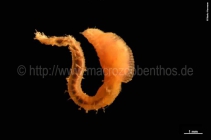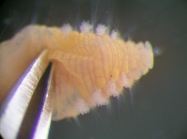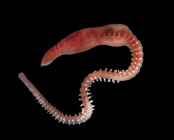| Introduction | | Species lists | | Search taxa | | Taxon tree | | Literature | | Distributions | | Statistics | | Editors | | Match taxa | | Webservice | | Log in |
WoRMS taxon detailsScalibregma Rathke, 1843
129555 (urn:lsid:marinespecies.org:taxname:129555)
accepted
Genus
Scalibregma inflatum Rathke, 1843 (type by monotypy)
Oligobranchus M. Sars, 1846 · unaccepted (subjective synonym)
marine,
recent only
neuter
Rathke, H. (1843). Beiträge zur Fauna Norwegens. [Contributions to the Fauna of Norway]. <em>Nova Acta Academiae Caesareae Leopoldino-Carolinae Naturae Curiosorum, Breslau & Bonn.</em> 20: 1-264., available online at https://doi.org/10.5962/bhl.title.11613
page(s): 182-184 [details]
Etymology Rathke (1843: 182, footnote) explains the derivation of Scalibregma as follows (translated): "The name is composed of...
Etymology Rathke (1843: 182, footnote) explains the derivation of Scalibregma as follows (translated): "The name is composed of (Greek for) front head and (Greek for) a tool for digging, scratching." Brown (1954) translates Greek bregma, -tos, neuter, as front part of the head, and Greek skalis -idos (feminine) as mattock or hoe. Thus Scalibregma means forehead hoe and the genus is neuter as the 2nd word bregma is neuter. [details]
Read, G.; Fauchald, K. (Ed.) (2025). World Polychaeta Database. Scalibregma Rathke, 1843. Accessed through: World Register of Marine Species at: https://www.marinespecies.org/aphia.php?p=taxdetails&id=129555 on 2025-05-05
Date action by
Nomenclatureoriginal description
Rathke, H. (1843). Beiträge zur Fauna Norwegens. [Contributions to the Fauna of Norway]. <em>Nova Acta Academiae Caesareae Leopoldino-Carolinae Naturae Curiosorum, Breslau & Bonn.</em> 20: 1-264., available online at https://doi.org/10.5962/bhl.title.11613 page(s): 182-184 [details] original description (of Oligobranchus M. Sars, 1846) Sars, M. (1846). Fauna littoralis Norvegiae oder Beschreibung und Abbildungen neuer oderwenig bekannter Seethiere, nebst Beobachtungen über die Organisation,Lebensweise und Entwickelung derselben. 1-194. Johann Dahk. Christiania., available online at https://www.biodiversitylibrary.org/page/45526545 page(s): 91 [details] Identification resourceidentification resource
Mendes, Samuel Lucas Da Silva Delgado; Rizzo, Alexandra E.; De Paiva, Paulo Cesar. (2023). Unravelling the diversity of Scalibregma Rathke, 1843 (Annelida: 'Polychaeta': Scalibregmatidae) from southeast Brazilian coast. <em>Zootaxa.</em> 5353(5): 441-454., available online at https://mapress.com/zt/article/view/zootaxa.5353.5.3 page(s): 452; note: Key to Scalibregma species [details] Available for editors Otheradditional source
Fauchald, K. (1977). The polychaete worms, definitions and keys to the orders, families and genera. <em>Natural History Museum of Los Angeles County: Los Angeles, CA (USA), Science Series.</em> 28:1-188., available online at http://www.vliz.be/imisdocs/publications/123110.pdf [details]
additional source Bellan, G. (2001). Polychaeta, <i>in</i>: Costello, M.J. <i>et al.</i> (Ed.) (2001). European register of marine species: a check-list of the marine species in Europe and a bibliography of guides to their identification. <em>Collection Patrimoines Naturels.</em> 50: 214-231. (look up in IMIS) note: checklist listing [details] additional source Day, J. H. (1967). [Sedentaria] A monograph on the Polychaeta of Southern Africa. Part 2. Sedentaria. British Museum (Natural History), London. pp. 459–842., available online at http://www.biodiversitylibrary.org/bibliography/8596 [details]  Present Present  Inaccurate Inaccurate  Introduced: alien Introduced: alien  Containing type locality Containing type locality
From editor or global species database
Diagnosis "Body elongate, arenicoliform. Prostomium T-shaped with lateral horns. Peristomium achaetous, surrounding prostomium dorsally and forming upper and lower lips of mouth ventrally. Parapodia of posterior segments with dorsal and ventral cirri; interramal papilla present; postsetal lamellae absent. Branchiae present in anterior segments. Chaetae include capillaries, lyrate chaetae, and sometimes inconspicuous blunt, pointed, or bifurcated spinous chaetae anterior to capillaries of chaetigers 1 or 1‒2, representing homologues of lyrate chaetae; large conspicuous acicular spines absent. Pygidium with long anal cirri." (Blake, 2015: 60).Blake (2015 & 2025) examines species differences within Scalibregma, but following his diagnoses provides no indication as to the unique characters of Scalibregma compared to the other scalibregmatid genera. The presence of anterior arborescent branchiae may be the most obvious differing character state, and presence of variable anal cirri and lobes may be relevant. [details] Etymology Rathke (1843: 182, footnote) explains the derivation of Scalibregma as follows (translated): "The name is composed of (Greek for) front head and (Greek for) a tool for digging, scratching." Brown (1954) translates Greek bregma, -tos, neuter, as front part of the head, and Greek skalis -idos (feminine) as mattock or hoe. Thus Scalibregma means forehead hoe and the genus is neuter as the 2nd word bregma is neuter. [details] Grammatical gender Neuter. Rathke (1843) gave the type species a neuter species-group name, 'inflatum', consistent with his derivation etymology, and about six of the following names from later authors were given neuter adjectival species-group names. [details] |




